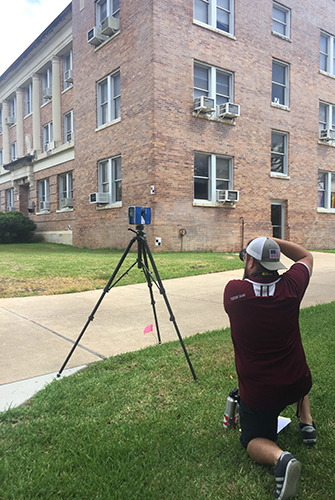Woodcock is now retired, but he stays involved with the CHC and holds the title of professor emeritus. He looks back on his career with the center fondly, remembering the people he worked with and special fieldwork, such as his time working on Montezuma Castle in Arizona.
“Montezuma Castle is a six-level cliff dwelling, so you have to climb up a series of ladders to reach it,” he said. “It’s an amazing structure and had never been documented accurately before. I also documented a stone fireplace carving in Wales, and it intrigued me that people were carving stone in Wales at roughly the same time Native American people were carving stone in Arizona. It puts you in the mindset that these artifacts aren’t just objects. Somebody made them, and it was meaningful to them; therefore, you treat these relics with a great sense of reverence.”
THE RECENT PAST
Episcopal Church in Bryan, Texas, Pointe du Hoc in Normandy, France, and many more. Currently, the center’s projects include Dabney Hill Missionary Baptist Church in Snook, Texas, and the Wheelock Schoolhouse in Hearne, Texas; both are supported by grants from the Texas Historic Commission and community fundraising.
 Center for Heritage Conservation students helped document Bizzell Hall on Texas A&M's campus prior to its demolition in 2017.
Center for Heritage Conservation students helped document Bizzell Hall on Texas A&M's campus prior to its demolition in 2017.
Smaller communities that are far away from major population centers such as Houston and Dallas often struggle to find preservationists and contractors willing and able to service their buildings. Texas A&M plays a special role in some of these cases since it can utilize its central Texas location and ability to work pro bono to give communities the preservation services they need. Wheelock Schoolhouse and Dabney Hill Church are two such examples of this partnership.
From the center’s earliest days as a documentation project, technology continues to be an integral part of its work. Priya Jain, an associate director of the center, works with infrared thermography to analyze a site’s architectural conditions, such as the presence of moisture and hidden structural details. She is extensively involved in the center’s current projects.
“I see the center as an interface between academia, practice and the community,” said Jain, who worked as an architect and preservationist before joining the Texas A&M faculty. “The feedback I receive from students when we work on projects like this has been amazing. They feel like they're not just learning theory, since they also visit buildings and make a tangible impact.”
LOOKING FORWARD
Named after the inaugural director and central figure in the center’s history, the David Woodcock Endowed Professorship in Historic Preservation provides financial support to the center’s director. “The David Woodcock Professorship is a resource I use to attend academic and professional conferences and to fund research,” said Glowacki, the current holder. “It also enables me to involve students in research and take them on projects, and sometimes it allows me to award scholarships to deserving students.”
Although historic conservation is often thought of as trying to suspend moments in time, the center’s goal is to help sites adapt to modern times, maintaining their complete histories and educating the public about the environments in which they live. “This is not an activity that looks backward; it is an activity that looks forward,” Woodcock said. “Conserving resources doesn’t mean not using them. It means using them wisely.”
To learn how you can support the David Woodcock Professorship in Historic Preservation or the Center for Heritage Conservation, contact Erik Baker at (979) 862-5765 or by submitting a message using the form below.